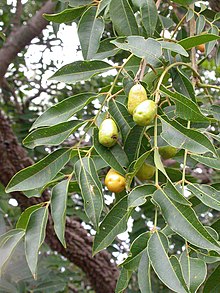Black-crowned marmoset
| Black-crowned marmoset | ||||||||||||
|---|---|---|---|---|---|---|---|---|---|---|---|---|
| Systematics | ||||||||||||
|
||||||||||||
| Scientific name of the genus | ||||||||||||
| Callibella | ||||||||||||
| M. van Roosmalen & T. van Roosmalen , 2003 | ||||||||||||
| Scientific name of the species | ||||||||||||
| Callibella humilis | ||||||||||||
| (M. van Roosmalen, T. van Roosmalen, Mittermeier & da Fonseca , 1998) |
The black-crowned marmoset ( Callibella humilis ) is a species of primate from the marmoset family (Callitrichidae).
features
Black-crowned marmosets reach a head body length of 16 to 17 centimeters, a tail length of 22 to 24 centimeters and a weight of 150 to 185 grams. After the pygmy marmosets, they are the second smallest marmosets and thus the second smallest monkeys . Their fur is olive-brown on the back, the belly is golden-yellow to gray-yellow, the hands and outside of the legs are orange and the long tail is black. The name-giving feature is a black head of hair, the ears and face are mostly hairless. There are white eyebrows above the eyes.
distribution and habitat
Black-crowned marmosets inhabit a small area in the Brazilian state of Amazonas between the Rio Madeira and the lower reaches of the Rio Aripuanã . Their habitat is the rainforest , they are often found in secondary forests and on the edge of the forest, and can also be found on plantations and in gardens.
Lifestyle and diet
Like all marmosets, these primates are diurnal and spend most of their life in the trees. They live in groups of six to eight animals, sometimes they also form larger groups of up to 30 animals. Unlike other marmosets, they are not territorial.
Like all marmosets , thanks to the specialized teeth in the lower jaw, they are able to gnaw holes in the tree bark in order to get to the tree sap, one of their main sources of food. They also eat insects and other small animals and, depending on the season, also fruit. An important source of tree sap is the Schefflera morototoni tree , fruits that are eaten with pleasure come from the yellow mombin plum ( Spondias mombin ) and Tapirira guianensis, both from the sumac family , as well as from Annona mucosa , Inga edulis and Inga ingoides , from the jackfruit tree , the palm Astrocaryum vulgare and the cocoa tree Theobroma speciosum .
Reproduction
In contrast to the other marmosets, the black-crowned marmosets reproduce several females in a group and not just the dominant one. Single births also predominate, and the common care for the young animals known from other marmosets was not observed in them - only the mother wears it.
threat
Because of its small distribution area, which is not protected, the species is listed by the IUCN as "endangered" ( vulnerable ). However, the species is very adaptable and there are no known acute threats. The total population was estimated at around 10,000 animals in 2003.
Systematics
The black-crowned marmoset was first described in 1998 under the scientific name Callithrix humilis . In 2003, the Dutch primatologist Marc van Roosmalen and his son Tomas van Roosmalen introduced the monotypical genus Callibella for the monkey and justified this primarily with a phylogenetic analysis based on a comparison of parts of the mitochondrial DNA , also with a different skull and Skeletal anatomy and the different way of life. Some scientists advocated placing the black-crowned marmoset in the genus Mico , as it would hardly differ morphologically from other Mico species. In the Handbook of the Mammals of the World and at the IUCN it is still listed as Callibella humilis . The black-crowned marmoset occupies a basal position in the family tree of the silk monkeys.
literature
- Russell A. Mittermeier , Anthony B. Rylands & Don E. Wilson : Handbook of the Mammals of the World: Primates: 3rd 2013, ISBN 978-8496553897
- Marc van Roosmalen , Tomas van Roosmalen: The Description of a New Marmoset Genus, Callibella (Callitrichinae, Primates), Including Its Molecular Phylogenetic Status . PDF .
- Don E. Wilson, DeeAnn M. Reeder (Eds.): Mammal Species of the World. A taxonomic and geographic Reference. Johns Hopkins University Press, Baltimore MD 2005, ISBN 0-8018-8221-4 .
Individual evidence
- ↑ a b c d A. B. Rylands & RA Mittermeier: Family Callitrichidae (Marmosets and Tamarins). Pages 308 in Russell A. Mittermeier , Anthony B. Rylands & Don E. Wilson : Handbook of the Mammals of the World: Primates: 3. (2013) ISBN 978-8496553897
- ↑ a b IUCN entry
- ^ MGM van Roosmalen, T. van Roosmalen, RA Mittermeier, & GAB Da Fonseca (1998). A new and distinctive species of marmoset (Callitrichidae, Primates) from the lower Rio Aripuanã, state of Amazonas, central Brazilian Amazonia. Goeldiana Zoologia, 22, 1-27.
- ^ MGM van Roosmalen & T. van Roosmalen (2003). The description of a new marmoset genus, Callibella (Callitrichinae, primates), including its molecular phylogenetic status . Neotropical Primates, 11, 1-12.
- ↑ Horacio Schneider, Jose Antonio R. Bernardi, Divino B. Da Cunha, Claudia H. Tagliaro, Marcelo Vallinoto, Steve F. Ferrari, Iracilda Sampaio: A molecular analysis of the evolutionary relationships in the Callitrichinae, with emphasis on the position of the dwarf marmoset. Zoologica Scripta, November 2011, DOI: 10.1111 / j.1463-6409.2011.00502.x
- ↑ Guilherme ST Garbino: How many marmoset (Primates: Cebidae: Callitrichinae) genera are there? A phylogenetic analysis based on multiple morphological systems. Cladistics, January 2015, DOI: 10.1111 / cla.12106
- ↑ Rodrigo Costa-Araújo, Fabiano R. de Melo, Gustavo Rodrigues Canale, Sandra M. Hernández-Rangel, Mariluce Rezende Messias, Rogério Vieira Rossi, Felipe E. Silva, Maria Nazareth Ferreira da Silva, Stephen D. Nash, Jean P. Boubli, Izeni Pires Farias and Tomas Hrbek. 2019. The Munduruku Marmoset: A New Monkey Species from southern Amazonia. PeerJ. 7: e7019. DOI: 10.7717 / peerj.7019
